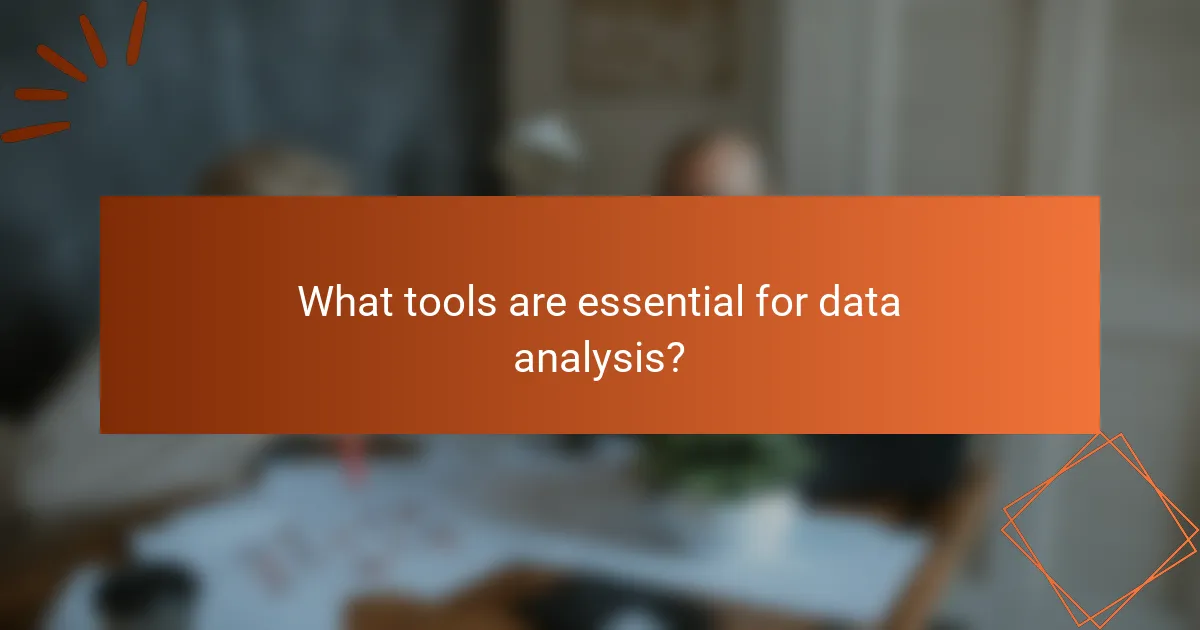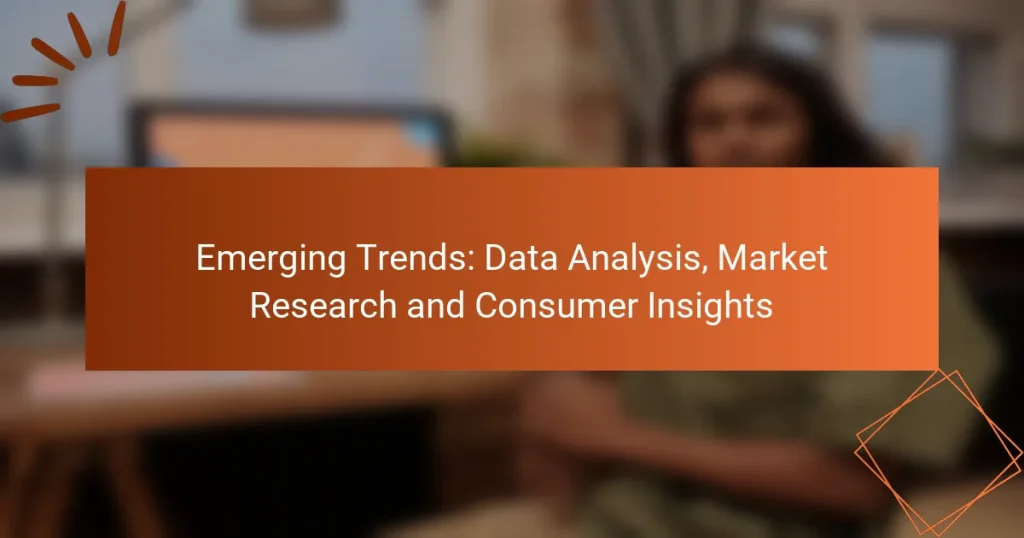Emerging trends in data analysis are transforming how businesses understand and engage with consumers. By harnessing advanced technologies such as artificial intelligence and real-time analytics, companies can extract actionable insights from extensive data sets, enabling more informed decision-making. This evolution in market research emphasizes the necessity of real-time data collection to adapt strategies that resonate with consumer behavior and preferences.

What are the emerging trends in data analysis?
Emerging trends in data analysis focus on leveraging advanced technologies to enhance decision-making and consumer understanding. Key developments include the integration of artificial intelligence, real-time analytics, and predictive analytics, which collectively enable businesses to derive actionable insights from vast amounts of data.
Artificial Intelligence in Data Processing
Artificial intelligence (AI) is revolutionizing data processing by automating complex tasks and improving accuracy. AI algorithms can analyze large datasets quickly, identifying patterns and trends that may not be apparent through traditional methods.
Businesses are increasingly adopting AI tools for tasks such as data cleaning, anomaly detection, and sentiment analysis. For example, AI can process customer feedback from various sources to gauge public sentiment about a brand or product, allowing companies to respond proactively.
Real-time Data Analytics
Real-time data analytics enables organizations to make immediate decisions based on current data. This trend is particularly valuable in industries such as finance and e-commerce, where timely insights can significantly impact operations and customer satisfaction.
By utilizing technologies such as stream processing and in-memory computing, businesses can analyze data as it is generated. For instance, a retail company can adjust its inventory in real-time based on customer purchasing trends, optimizing stock levels and reducing waste.
Predictive Analytics Adoption
Predictive analytics involves using historical data to forecast future outcomes, helping businesses anticipate trends and customer behavior. This approach is gaining traction across various sectors, including healthcare, marketing, and supply chain management.
Organizations can implement predictive models to enhance customer targeting and improve operational efficiency. For example, a marketing team might use predictive analytics to identify potential customers likely to convert, allowing for more focused advertising efforts. However, it’s essential to ensure data quality and relevance to achieve accurate predictions.

How is market research evolving in 2023?
Market research in 2023 is increasingly leveraging technology and data analytics to gain deeper insights into consumer behavior. This evolution emphasizes the importance of real-time data collection and analysis to inform business strategies and decision-making.
Increased Use of Online Surveys
Online surveys have become a primary method for gathering consumer feedback due to their cost-effectiveness and speed. Businesses can quickly reach a wide audience, often achieving response rates in the low double digits to low teens percent.
To maximize effectiveness, surveys should be concise and mobile-friendly, as many users prefer to respond on their smartphones. Offering incentives, such as discounts or entry into a prize draw, can also boost participation rates.
Integration of Social Media Analytics
Social media analytics is now a crucial component of market research, providing insights into consumer sentiments and trends. By analyzing engagement metrics and user-generated content, businesses can gauge public opinion and identify emerging trends in real-time.
Tools like sentiment analysis software can help quantify consumer feelings towards brands or products, allowing companies to adjust their marketing strategies accordingly. Regularly monitoring platforms like Twitter, Instagram, and Facebook can reveal valuable insights into customer preferences and behaviors.
Focus on Consumer Behavior Tracking
Tracking consumer behavior has become essential for understanding purchasing patterns and preferences. Businesses are increasingly using data from various sources, including website analytics and purchase history, to create detailed consumer profiles.
Implementing tools like customer relationship management (CRM) systems can help businesses analyze this data effectively. Companies should be cautious about privacy regulations, ensuring compliance with laws such as GDPR when collecting and storing consumer data.

What consumer insights are shaping business strategies?
Consumer insights are critical for businesses to tailor their strategies effectively. By analyzing customer behavior, preferences, and feedback, companies can make informed decisions that enhance engagement and drive sales.
Personalization of Marketing Campaigns
Personalization in marketing campaigns involves customizing messages and offers based on individual consumer data. This approach increases relevance and can significantly boost conversion rates, with studies showing that personalized emails can lead to higher open and click-through rates.
To implement personalization, businesses should gather data on customer preferences through surveys, purchase history, and online behavior. Using this data, companies can segment their audience and create targeted campaigns that resonate with specific groups.
Data-Driven Decision Making
Data-driven decision making relies on analytics to guide business strategies and operational choices. By leveraging data, companies can identify trends, optimize processes, and allocate resources more effectively, often resulting in improved performance and profitability.
Key steps include collecting relevant data, analyzing it to extract actionable insights, and integrating these findings into strategic planning. Businesses should avoid relying solely on intuition; instead, they should use data as a foundation for their decisions to minimize risks and maximize outcomes.
Understanding Customer Journeys
Understanding customer journeys involves mapping out the various stages a consumer goes through from awareness to purchase and beyond. This insight helps businesses identify pain points and opportunities to enhance the customer experience.
To effectively analyze customer journeys, companies can utilize tools like customer journey mapping and analytics software. Regularly reviewing these journeys allows businesses to adapt their strategies and improve customer satisfaction, ultimately leading to increased loyalty and repeat business.

What tools are essential for data analysis?
Essential tools for data analysis include software that helps visualize data, track web performance, and conduct statistical evaluations. Choosing the right tool depends on the specific needs of your analysis, such as the type of data and the insights you aim to gain.
Tableau for Data Visualization
Tableau is a powerful tool for data visualization that allows users to create interactive and shareable dashboards. It connects to various data sources and enables users to visualize data trends and patterns effectively.
When using Tableau, consider the types of visualizations that best represent your data, such as bar charts for comparisons or line graphs for trends over time. A common pitfall is overloading dashboards with too much information, which can confuse viewers.
Google Analytics for Web Insights
Google Analytics is essential for tracking and analyzing web traffic, providing insights into user behavior on your website. It helps businesses understand how visitors interact with their site, which pages are most popular, and where users drop off.
To maximize Google Analytics, set up goals to track conversions and utilize segmentation to analyze different user groups. Avoid relying solely on aggregate data; instead, dive deeper into user flows and behavior for actionable insights.
SPSS for Statistical Analysis
SPSS (Statistical Package for the Social Sciences) is widely used for statistical analysis in various fields, including market research and social sciences. It offers a range of statistical tests and procedures that can help in interpreting complex data sets.
When using SPSS, ensure that your data is clean and well-organized for accurate analysis. Familiarize yourself with key functions like regression analysis and ANOVA to derive meaningful conclusions. A common mistake is misinterpreting results due to a lack of understanding of statistical significance, so always check your assumptions before drawing conclusions.

How to choose the right market research method?
Choosing the right market research method involves understanding your objectives, available resources, and the type of data you need. Consider whether you require qualitative insights or quantitative data to guide your decision-making process.
Qualitative vs. Quantitative Approaches
Qualitative approaches focus on understanding consumer behavior and motivations through methods like interviews and focus groups. These methods provide in-depth insights but may not represent the broader population.
In contrast, quantitative approaches involve collecting numerical data through surveys or experiments, allowing for statistical analysis. This method is beneficial for identifying trends and making generalizations about larger groups.
Cost Considerations
Cost is a critical factor when selecting a market research method. Qualitative research can be more expensive due to the need for skilled facilitators and smaller sample sizes, often ranging from hundreds to thousands of dollars.
Quantitative research typically offers a wider reach at a lower cost per respondent, especially with online surveys, which can be conducted for a few hundred to a few thousand dollars depending on the sample size and complexity.
Target Audience Alignment
Aligning your research method with your target audience is essential for obtaining relevant insights. For niche markets, qualitative methods may yield richer information, while broader audiences may require quantitative surveys to capture diverse opinions.
Consider demographic factors such as age, location, and preferences when selecting your method. Tailoring your approach to fit the audience ensures that the data collected is actionable and meaningful for your objectives.

What are the best practices for consumer insights?
Best practices for consumer insights involve systematically gathering and analyzing data to understand consumer behavior and preferences. This process enables businesses to make informed decisions that align with market demands and enhance customer satisfaction.
Utilize a mix of qualitative and quantitative methods
Combining qualitative and quantitative research methods provides a comprehensive view of consumer insights. Quantitative methods, such as surveys and analytics, yield numerical data that can be statistically analyzed, while qualitative methods, like focus groups and interviews, offer deeper contextual understanding. This mixed approach helps capture the nuances of consumer behavior.
Segment your audience effectively
Effective audience segmentation allows businesses to tailor their strategies to specific consumer groups. By analyzing demographics, psychographics, and purchasing behavior, companies can create targeted marketing campaigns that resonate with different segments. For instance, a brand might segment its audience by age, income level, or lifestyle preferences to enhance engagement.
Leverage technology and tools
Utilizing advanced analytics tools and technologies can streamline the process of gathering consumer insights. Tools such as customer relationship management (CRM) systems, social media analytics, and data visualization software can help businesses track consumer interactions and preferences in real-time. Implementing these technologies can lead to more agile decision-making and improved customer experiences.
Regularly update your insights
Consumer preferences and market conditions change frequently, so it’s crucial to regularly update insights. Conducting periodic research and monitoring trends ensures that businesses remain relevant and responsive to their audience’s needs. Setting a schedule for reviews, such as quarterly or bi-annually, can help maintain a fresh understanding of the market landscape.
Communicate insights across the organization
Sharing consumer insights across departments fosters a culture of informed decision-making. When marketing, product development, and customer service teams have access to the same insights, they can align their strategies and initiatives. Regular meetings or shared platforms can facilitate this communication, ensuring that everyone is on the same page regarding consumer needs and expectations.


